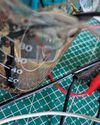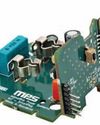The Connect Between Open Source And The Metaverse
Electronics For You
|August 2023
This article looks at the relationship between the metaverse and open source. It outlines a few key areas where open source is playing a pivotal role in realising the full potential of the metaverse. It also explores the opportunity that this iteration of the internet and associated virtual spaces presents to reinvent open source
-

The metaverse is loosely defined as “a combination of the virtual reality and mixed reality worlds accessed through a browser or a headset, which allows people to have real time interactions and experiences across distance.” It is generating a lot of attention now, as it matures beyond its previous predominant realm of gaming into its much broader field of application as a place not only to play but also to socialise and work.
Both ‘metaverse’ and ‘open source’ are catch-all phrases in their relative fields, covering everything from technology and communities, to markets, methodologies, and more.
A considerable number of components of the metaverse are being developed as open source projects, according to open source principles—for example, self-sovereign identity (SSI) and smart contracts, both of which are built on blockchain technology.
Interoperability and connectedness
One of the reasons the internet has been so lucrative and transformative is because of how it was created. Throughout the 1960s to 1990s, the foundation of today’s internet was built through a variety of consortiums and informal working groups composed of government research labs, public universities, and independent technologists. These usually not-for-profit collectives typically focused on establishing open standards that would help them share information from one server to another (i.e., messages or files), and in doing so make it easier to collaborate on future technologies, projects, and ideas.
This story is from the August 2023 edition of Electronics For You.
Subscribe to Magzter GOLD to access thousands of curated premium stories, and 10,000+ magazines and newspapers.
Already a subscriber? Sign In
MORE STORIES FROM Electronics For You

Electronics For You
Tech Majors Are Racing TOWARDS NET-ZERO - What About You?
Apple, Microsoft, Amazon, Google, Infosys, Wipro—global and Indian firms are heading closer to achieving net-zero emissions, a mandate to combat climate change. Here is what you need to know to start your journey...
12 mins
December 2025

Electronics For You
Miniature IoT WATER TDS And LEVEL MONITOR Cum CONTROLLER
For setups that rely on stored water, clear awareness of tank level and water quality is essential.
3 mins
December 2025

Electronics For You
The Impact Of GENERATIVE AI On The Future Of AUTOMOTIVE AND EVs
Autonomous vehicles, connected ecosystems, and smart factories are only the beginning. Generative Al is pushing the auto industry beyond predictions into a bold era of creativity-from EV design to real-time diagnostics and showroom automation. Here is how GenAl is reshaping innovation across the automotive value chain.
8 mins
December 2025

Electronics For You
How AI Tools Are Making SOFTWARE DEVELOPMENT BETTER
AI is reshaping how we code, debug, and collaborate. From Copilot to automation, it is changing software development in ways worth exploring.
3 mins
December 2025
Electronics For You
How AI Tools Are Making SOFTWARE DEVELOPMENT BETTER
AI is reshaping how we code, debug, and collaborate. From Copilot to automation, it is changing software development in ways worth exploring.
3 mins
December 2025

Electronics For You
5 Interesting Reference Designs FOR SMART HOMES
Smart home devices are transforming the way people interact with their appliances. They make homes more convenient, secure, and energy-efficient. From smart plugs and energy monitors to smart locks and thermostats, reference designs help design engineers create connected products that are easy to use, consume less power, and are reliable. These designs allow you to control devices remotely, track energy use, extend battery life, and automate routines. They provide practical solutions for upgrading homes and small commercial spaces without major modifications.
3 mins
December 2025

Electronics For You
Fancy USB LED VASE
This USB LED vase is a simple yet elegant device that fuses art with electronics to create a decorative lighting display. Powered directly from a standard USB port, it uses readily available components such as MOSFETs, resistors, capacitors, and LEDs to produce a striking, dynamic sequence of lights.
3 mins
December 2025

Electronics For You
"WHAT OTHERS SELL IN FOUR BOXES WE BUILT IN ONE"
Years of custom field work are shaping a product line with its own cloud, its own hardware, and a market that is now beginning to recognise its value.
8 mins
December 2025

Electronics For You
BUILD LARGE LANGUAGE MODELS
Large language models are machine learning models designed for a range of language-related tasks such as text generation and translation. Here’s how open source software can help you build your own large language model.
6 mins
December 2025

Electronics For You
Rare Earth Or Rare Ingenuity? India Remains Between The Two
With China firmly controlling rare earth exports, India confronts a critical moment in its technological trajectory.
8 mins
December 2025
Translate
Change font size

